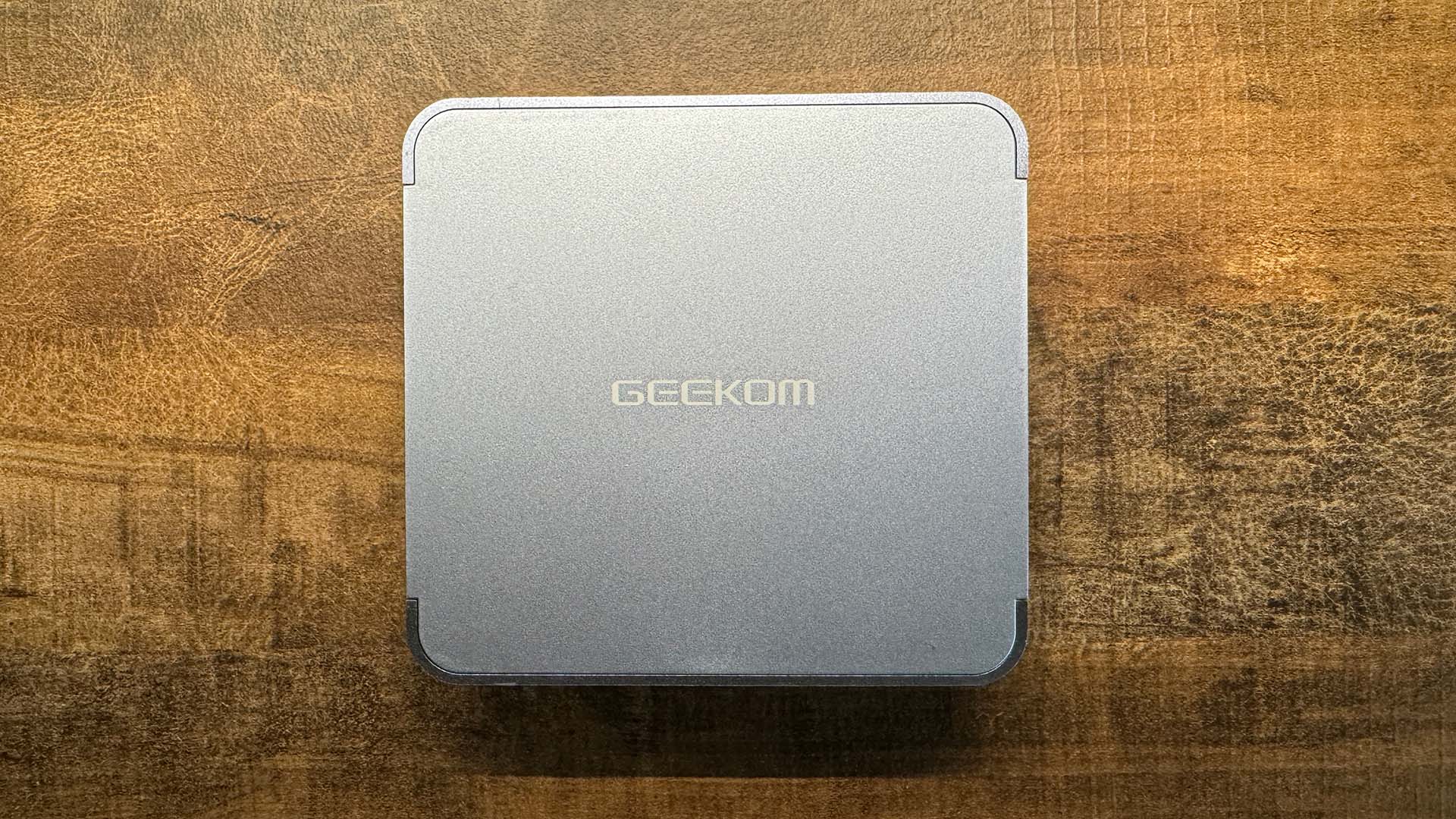
Tiny but mighty. The AX8 Pro is not just a mini PC, it's the miniest PC.
As I hefted the AX8 Pro from its packaging, my first impression was of a pleasing weight and density. My second was: “Holy CRAP this thing is small!”
I’m not kidding, the AX8 Pro is an absolute marvel of miniaturisation. Measuring just 11.1cm x 11.7cm x 3.8cm, it’s the most compact mini-PC we’ve tested by some margin, And within this tiny frame is housed one of the latest and best AMD APUs.
Featuring eight cores and sixteen threads, the Ryzen 9 8945HS is a great little chip. In stress-testing, we saw it draw a peak of 65 W, boosting from its base clock speed of 4 GHz to a healthy 5.2 GHz, with a peak operating temperature of 92 °C under sustained loads. That might feel a bit on the balmy side, but it’s still eight degrees short of the CPU’s 100 °C TJMax rating, the point at which throttling kicks in.
Paired with this fine silicon is the Radeon 780M iGPU, aka RDNA 3, and this is probably the last generation of chips we’ll see it in. AMD’s upcoming, AI-branded Zen 5 mobile APUs will feature a Radeon 890M GPU with RDNA 3.5, and our Zen 5 laptop testing so far shows how strong that is. But until they hit the mainstream, the Radeon 780M is still the most reliably performant iGPU around, bettered only by the leap in performance—and commensurate cost—of adding a discrete mobile GPU into the mix, which we see in the likes of the ASUS ROG NUC.
(Image credit: Future)
APU: AMD Ryzen 9 8945HS
iGPU: Radeon 780M
Memory: 32GB DDR5 5600Mhz SODIMM
Storage: 2TB M.2 PCIe Gen4
Wireless: WiFi 6E, Bluetooth 5.3
I/O: front: 2x USB 3.2 Gen 2 Type-A, 3.5mm Headset jack
I/O rear: 2x HDMI 2.0, 1x USB4 Type-C, 1USB 3.2 Type-C, 1x 2.5G LAN, 1x USB 3.2 Type-A, 1x USB 2.0 Type-A
Price: $899 | £949
What this all adds up to is a powerful, do-it-all mini-PC, a machine you can use equally for work and pleasure, with desktop-chasing productivity chops and muscle enough to run most games well at 1080p. A lot of its gaming performance hinges on that Radeon 780M, so it’s no surprise to find it trades blows with previous-gen APUs equipped with the same iGPU, such as the Ryzen 7 7840HS and Ryzen 9 7940HS, and on the Intel side, the Arc-wielding Core 9 Ultra 185H.
Indie and older games are where the 780M shines and there’s oodles of fun to be had at 1080p with medium graphics settings. In our testing we found Subnautica running nice and smooth at 55-75 fps, Stray at a similarly svelte 52-75 fps, Soulstone Survivors between 80 and 120 fps, and Doom Eternal at a gore-slick 70-80 fps.
Moving to more modern and demanding AAA titles at 1080p, using medium detail settings and FSR set to auto where the engine proffers it, the AX8 Pro holds its own against those aforementioned peers, and sometimes exceeds them, but never pulls ahead by more than a nose. It puts in a solid showing with Total War: WARHAMMER 3’s battle and campaign benchmarks, achieving 42 fps and 33 fps respectively. Forza gets you an unflinching 46 fps. Homeworld 3’s tough benchmark sees an average of 39 fps, while Cyberpunk 2077 enjoys a healthy 51 fps.
There are quieter mini PCs out there, but this thing is so compact, I’m genuinely staggered that it doesn’t sound like a Lilliputian Airbus.
Under heavy loads, the AX8 Pro’s cooling solution gets a bit blowy, but it’s the sound of air being pressed through fan-grills; there’s none of the whistling whine so common with small, high-RPM fans. You’re hearing the airflow generated by the mechanism, not the mechanism itself, and while it’s initially quite noticeable, it’s a sound you can mostly zone out. There are quieter mini PCs out there, but this thing is so compact, I’m genuinely staggered that it doesn’t sound like a Lilliputian Airbus.
Some furtive noodling around the BIOS reveals three fan modes which you can switch between to alter the cooling and sound profiles. Shifting between Quiet, Normal, and Performance modes does indeed alter the max fan speed and associated volume, but in testing we discovered that it also alters the TDP, with the fan curve shifting to match lesser or greater wattage limits and their adjuvant heat generation, so the label ‘fan mode’ doesn’t quite paint the full picture.
Running Prime95 to stress the chip and using HWInfo64 to measure the changes, Silent mode saw the CPU draw 51 W to hit a max turbo speed of 5.1 GHz and a max temp of 83 Celsius. Normal mode draws 59 W, which gets you 5.1 GHz at 89°C, and Performance mode pulls 65 W to hit the CPU’s max clock speed of 5.2 GHz and pushes the temperature to 92 °C. Our shrink-wrapped AX8 Pro retail sample was set to Performance out of the box, so all the benchmarks above were conducted in this mode.
Running Prime95 to stress the chip and using HWInfo64 to measure the changes, Silent mode saw the CPU draw 51 W to hit a max turbo speed of 5.1 GHz and a max temp of 83 Celsius. Normal mode draws 59 W, which gets you 5.1 GHz at 89 °C, and Performance mode pulls 65 W to hit the CPU’s max clock speed of 5.2 GHz and pushes the temperature to 92 °C. Our shrink-wrapped AX8 Pro retail sample was set to Performance out of the box, so all the benchmarks above were conducted in this mode.
(Image credit: Future)
(Image credit: Future)
(Image credit: Future)
TDP changes can affect performance of course, so our final test was to rerun Cyberpunk but noticeably hiking the fan-noise to a prominent level. Other games may or may not benefit more from the jump up to 65 W, but if so, it’s hard to imagine a significant level of uptick. Our recommendation would be to drop the fan mode to Normal and leave it there.
In performance terms, the average frame rates achieved by the AX8 Pro are what we’ve come to expect from mini-PCs running games on the Radeon 780M at 1080p. Assuming any Ryzen APU paired with the 780M isn’t run at an undercooked wattage, it makes for a fairly level playing field between such chips and devices in terms of games performance. There’s no denying that the AX8 Pro’s Ryzen 9 8945HS enables it to achieve higher frame rates than its peers in some titles, but incrementally so. And that’s no surprise as, on paper, AMD’s 7th-gen and 8th-gen Ryzen 9 mobile APUs appear identical.
Both the 7940HS and 8945HS boast eight cores, achieve a turbo clock speed of 5.2 GHz, they both have the same L1, L2 and L3 cache sizes, they’re rated by AMD to run at the same 45-54 W TDP, and they both lean on the Radeon 780M for gaming. Same transistor count, same everything, as far as I can glean from AMD’s spec-sheets, which read like a cut-and-paste job. Geekom’s implementation here, which pushes the CPU to operate above its stated TDP-rating of 54 W, is most likely what gives it that minimal performance edge. But the fact remains, you’re paying a huge premium here for a slightly newer CPU which is effectively a rebadge of the previous generation, and in most titles there’s no performance difference at all.
(Image credit: Future)
(Image credit: Future)
(Image credit: Future)
✅ You demand the dinkiest: It’s tiny. You could literally slip this thing in the back pocket of your jeans.
✅ You want great performance at 1080p: An excellent all-rounder with power enough for gaming at 1920×1080
❌ You’re on a budget: The price tag is just shy of a grand, and there’s no barebones option.
❌ You want a silent performer: With a powerful APU in a tiny case, the fan needs to hustle
One of the attractions of mini-PCs is the fact that they grant snappy general-computing and 1080p gaming power on a budget, and the AX8 Pro is objectively not a bargain compared to the prices of its competing stablemates. Plus, Zen 5 APUs which wield the new RDNA3.5 iGPU, aka the Radeon 890M, are beginning to trickle into devices. The talented Mr. Ridley found that even in a lower-wattage notebook scenario, the Radeon 890M grants a tangible performance uplift over the 780M. It’s going to be interesting to see if that performance is further improved at the kind of TDP levels offered by boxes like the AX8 Pro. So if you’re thinking of dropping this amount of money on a top-end mini-PC, it might pay to wait just a little longer.
If you want the smallest PC on the planet with a highly performant APU, the Geekom AX8 Pro is just that. But be aware that you can spend considerably less and achieve near-identical results.






